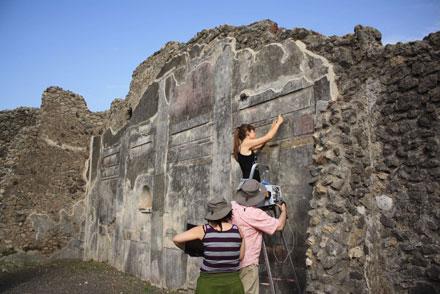Pollution Turns Red Into Black
Art Conservation: Atmospheric sulfur dioxide blackens pigments in Pompeian frescoes
Sarah Webb
Source -http://pubs.acs.org/cen/news/89/i16/8916scene.html?utm_source=feedburner&utm_medium=feed&utm_campaign=Feed%3A+cen_latestnews+%28Chemical+%26+Engineering+News%3A+Latest+News%29

Maite Maguregui - Spanish and Finnish researchers study how sulfur dioxide has blackened red pigments in Pompeii's ancient frescos.
The ruins of the ancient city of Pompeii, Italy, buried by a volcanic eruption in A.D. 79, have fascinated archaeologists and historians for centuries. Unfortunately, air pollution from nearby Naples threatens the ruins' art. Now Spanish and Finnish researchers have demonstrated that atmospheric sulfur dioxide blackens pigments in the frescos (Anal. Chem., DOI: 10.1021/ac1029192).
The researchers examined paintings on the walls of a house in Pompeii. In some areas, the paintings' red pigments, made from hematite (anhydrous Fe2O3), have developed dark splotches containing magnetite (Fe3O4). Previous measurements had suggested that atmospheric pollutants might cause chemical changes in the plasters and pigments, says Maite Maguregui, a graduate student at the University of the Basque Country in Bilbao, Spain.
She and her colleagues used portable Raman, infrared, and X-ray fluorescence spectrometry to examine on-site the chemical process behind this blackening, and took small samples back to the laboratory for further study. The researchers found magnetite on the wall's surface only in places that also contained gypsum (CaSO4•2H2O). But gypsum was not an original component of the walls or the mortar.
The scientists reasoned that atmospheric SO2 reduced the hematite to magnetite. The resulting sulfur trioxide interacted with water to form sulfuric acid, which then reacted with calcite (CaCO3) in the walls to produce gypsum. The Pompeii walls provide the first example of this type of iron oxide transformation in pigments, Maguregui says.
This chemical process complicates conservation of these ancient walls, she adds. Because the pigments now sit within a layer of gypsum, which is highly soluble, rainwater could wash away the pigments with the gypsum, she says.
